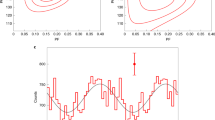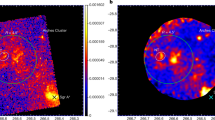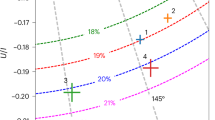Abstract
Massive stars die an explosive death as a core-collapse supernova (CCSN). The exact physical processes that cause the collapsing star to rebound into an explosion are not well understood1,2,3, and the key to resolving this issue may lie in the measurement of the shape of CCSNe ejecta. Spectropolarimetry is the only way to perform this measurement for CCSNe outside the Milky Way and Magellanic Clouds. We present the infrared spectropolarimetric detection of a CCSN enabled by the new highly sensitive WIRC+Pol instrument at Palomar Observatory, which can observe CCSNe (magnitude M = −17 mag) out to 20 Mpc at ~0.1% polarimetric precision. Infrared spectropolarimetry is less affected than optical spectropolarimetry by dust scattering in the circumstellar and interstellar media, thereby providing a less biased probe of the intrinsic geometry of the supernova ejecta. SN 2018hna, a SN 1987A-like explosion, shows 2.0 ± 0.3% continuum polarization in the J band oriented at ~160° on sky 182 days after the explosion. Assuming a prolate geometry as in SN 1987A, we infer an ejecta axis ratio of <0.48 with the axis of symmetry pointing at a 70° position angle. The axis ratio is similar to that of SN 1987A, suggesting that the two CCSNe may share intrinsic geometry and inclination angles. Our data do not rule out oblate ejecta. We also observe one other CCSN and two thermonuclear supernovae in the J band. Supernova 2020oi, a stripped-envelope type Ic SN in Messier 100 has broadband p = 0.37 ± 0.09% at peak light, indicative of either a 10% asymmetry or host interstellar polarization. The type Ia SNe 2019ein and 2020ue have <0.33% and <1.08% polarization near peak light, indicative of asymmetries of less than 10% and 20%, respectively.
This is a preview of subscription content, access via your institution
Access options
Access Nature and 54 other Nature Portfolio journals
Get Nature+, our best-value online-access subscription
$29.99 / 30 days
cancel any time
Subscribe to this journal
Receive 12 digital issues and online access to articles
$119.00 per year
only $9.92 per issue
Buy this article
- Purchase on Springer Link
- Instant access to full article PDF
Prices may be subject to local taxes which are calculated during checkout




Similar content being viewed by others
Data availability
The data that support the findings of this study are available from the corresponding author upon reasonable request.
Code availability
The WIRC+Pol data reduction pipeline can be publicly accessed at https://github.com/WIRC-Pol/wirc_drp. The specific scripts used to reproduce the results of this study are available from the corresponding author upon reasonable request.
References
Smartt, S. J. Progenitors of core-collapse supernovae. Annu. Rev. Astron. Astrophys. 47, 63–106 (2009).
Langer, N. Presupernova evolution of massive single and binary stars. Annu. Rev. Astron. Astrophys. 50, 107–164 (2012).
Woosley, S. E. & Heger, A. The remarkable deaths of 9-11 solar mass stars. Astrophys. J. 810, 34 (2015).
Janka, H.-T. Explosion mechanisms of core-collapse supernovae. Annu. Rev. Nucl. Part. Sci. 62, 407–451 (2012).
Burrows, A., Radice, D. & Vartanyan, D. Three-dimensional supernova explosion simulations of 9-, 10-, 11-, 12-, and 13-M⊙ stars. Mon. Not. R. Astron. Soc. 485, 3153–3168 (2019).
Maoz, D., Mannucci, F. & Nelemans, G. Observational clues to the progenitors of type Ia supernovae. Annu. Rev. Astron. Astrophys. 52, 107–170 (2014).
Riess, A. G. et al. Observational evidence from supernovae for an accelerating universe and a cosmological constant. Astron. J. 116, 1009–1038 (1998).
Perlmutter, S. et al. Measurements of Ω and Λ from 42 high-redshift supernovae. Astrophys. J. 517, 565–586 (1999).
Cikota, A. et al. Linear spectropolarimetry of 35 Type Ia supernovae with VLT/FORS: an analysis of the Si II line polarization. Mon. Not. R. Astron. Soc. 490, 578–599 (2019).
Yang, Y. et al. The young and nearby normal type Ia Supernova 2018gv: UV-optical observations and the earliest spectropolarimetry. Astrophys. J. 902, 46 (2020).
Wang, L. & Wheeler, J. C. Spectropolarimetry of supernovae. Annu. Rev. Astron. Astrophys. 46, 433–474 (2008).
Nagao, T., Maeda, K. & Tanaka, M. Circumstellar light echo as a possible origin of the polarization of type IIP supernovae. Astrophys. J. 847, 111 (2017).
Nagao, T., Maeda, K. & Tanaka, M. Multi-band polarization of type IIP supernovae due to light echo from circumstellar dust. Astrophys. J. 861, 1 (2018).
Voshchinnikov, N. V. Interstellar extinction and interstellar polarization: old and new models. J. Quant. Spectrosc. Radiat. Transf. 113, 2334–2350 (2012).
Whittet, D. C. B. et al. Systematic variations in the wavelength dependence of interstellar linear polarization. Astrophys. J. 386, 562 (1992).
Pinto, P. A. & Eastman, R. G. The physics of type IA supernova light curves. II. Opacity and diffusion. Astrophys. J. 530, 757–776 (2000).
Escuti, M. J., Oh, C., Sánchez, C., Bastiaansen, C. & Broer, D. J. Simplified spectropolarimetry using reactive mesogen polarization gratings. Proc. SPIE 6302, 630207 (2006).
Millar-Blanchaer, M., Moon, D.-S., Graham, J. R. & Escuti, M. Polarization gratings for visible and near-infrared astronomy. Proc. SPIE 9151, 91514I (2014).
Manchado, A. et al. First light for LIRIS (long-slit intermediate-resolution infrared spectrograph). Proc. SPIE 5492, 1094–1104 (2004).
Watanabe, M. et al. Near-infrared adaptive optics imaging- and spectro-polarimetry with the infrared camera and spectrograph of the Subaru Telescope. Proc. SPIE 10702, 107023V (2018).
Tinyanont, S. et al. WIRC+Pol: a low-resolution near-infrared spectropolarimeter. Publ. Astron. Soc. Pac. 131, 025001 (2019).
Tinyanont, S. et al. Achieving a spectropolarimetric precision better than 0.1% in the near-infrared with WIRC+Pol. Proc. SPIE 11132, 1113209 (2019).
Singh, A. et al. SN 2018hna: 1987A-like supernova with a signature of shock Breakout. Astrophys. J. Lett. 882, L15 (2019).
Dessart, L. & Hillier, D. J. Synthetic line and continuum linear-polarization signatures of axisymmetric type II supernova ejecta. Mon. Not. R. Astron. Soc. 415, 3497–3519 (2011).
Hoflich, P. Asphericity effects in scatterring dominated photospheres. Astron. Astrophys. 246, 481–489 (1991).
Jeffery, D. J. Catalog of SN 1987A polarimetry corrected for interstellar polarization. Astrophys. J. Suppl. 77, 405–415 (1991).
Wang, L. et al. The axisymmetric ejecta of supernova 1987A. Astrophys. J. 579, 671–677 (2002).
Morris, T. & Podsiadlowski, P. The triple-ring nebula around SN 1987A: fingerprint of a binary merger. Science 315, 1103–1106 (2007).
Bellm, E. C. et al. The Zwicky Transient Facility: system overview, performance, and first results. Publ. Astron. Soc. Pac. 131, 018002 (2019).
De, K. et al. Palomar Gattini-IR: survey overview, data processing system, on-sky performance and first results. Publ. Astron. Soc. Pac. 132, 025001 (2020).
Itagaki, K. Transient discovery report for 2018-10-22. Transient Name Server Discovery Report 2018-1614 (2018).
Leadbeater, R. Transient classification report for 2018-10-26. Transient Name Server Classification Report 2018-1638 (2018).
Schlafly, E. F. & Finkbeiner, D. P. Measuring reddening with Sloan Digital Sky Survey stellar spectra and recalibrating SFD. Astrophys. J. 737, 103 (2011).
Dessart, L. & Hillier, D. J. Supernovae from blue supergiant progenitors: what a mess! Astron. Astrophys. 622, A70 (2019).
Allen, D. A. et al. Supernova 1987A in the Large Magellanic Cloud. International Astronomical Union Circular 4351 (1987).
West, R. M. et al. Supernova 1987A in the Large Magellanic Cloud. International Astronomical Union Circular 4319 (1987).
Bailey, J. Spectropolarimetry of SN 1987A with the AAT. Proc. Astron. Soc. Aust. 7, 405–411 (1988).
Tonry, J. et al. ATLAS Transient discovery report for 2019-05-01. Transient Name Server Discovery Report 2019-678 (2019).
Burke, J., Arcavi, I., Howell, D. A., Hiramatsu, D. & McCully, C. Classification of AT 2019ein as a young SN Ia-peculiar. Transient Name Server AstroNote 8 (2019).
Pellegrino, C. et al. Constraining the source of the high-velocity ejecta in type Ia SN 2019ein. Astrophys. J. 897, 159 (2020).
Forster, F. et al. ALeRCE/ZTF transient discovery report for 2020-01-07. Transient Name Server Discovery Report 2020-67 (2020).
Siebert, M. R., Kilpatrick, C. D., Foley, R. J. & Cartier, R. UCSC transient classification report for 2020-01-09. Transient Name Server Classification Report 2020-90 (2020).
Horesh, A. et al. A non-equipartition shock wave traveling in a dense circumstellar environment around SN 2020oi. Astrophys. J. 903, 132 (2020).
Kawabata, M. Transient classification report for 2020-01-12. Transient Name Server Classification Report 2020-114 (2020).
Horne, K. An optimal extraction algorithm for CCD spectroscopy. Publ. Astron. Soc. Pac. 98, 609–617 (1986).
Wardle, J. F. C. & Kronberg, P. P. The linear polarization of quasi-stellar radio sources at 3.71 and 11.1 centimeters. Astrophys. J. 194, 249–255 (1974).
Jensen-Clem, R. et al. Point source polarimetry with the Gemini Planet Imager: sensitivity characterization with T5.5 dwarf companion HD 19467 B. Astrophys. J. 820, 111 (2016).
Masci, F. J. et al. The Zwicky Transient Facility: data processing, products, and archive. Publ. Astron. Soc. Pac. 131, 018003 (2019).
Cushing, M. C., Vacca, W. D. & Rayner, J. T. Spextool: a spectral extraction package for SpeX, a 0.8-5.5 micron cross-dispersed spectrograph. Publ. Astron. Soc. Pac. 116, 362–376 (2004).
Vacca, W. D., Cushing, M. C. & Rayner, J. T. A method of correcting near-infrared spectra for telluric absorption. Publ. Astron. Soc. Pac. 115, 389–409 (2003).
Oke, J. B. et al. The Keck low-resolution imaging spectrometer. Publ. Astron. Soc. Pac. 107, 375–385 (1995).
Leonard, D. C., Li, W., Filippenko, A. V., Foley, R. J. & Chornock, R. Evidence for spectropolarimetric diversity in type Ia supernovae. Astrophys. J. 632, 450–475 (2005).
Wang, L. et al. Premaximum spectropolarimetry of the type Ia SN 2004dt. Astrophys. J. 653, 490–502 (2006).
Tanaka, M. et al. Spectropolarimetry of the unique type Ib supernova 2005bf: larger asymmetry revealed by later-phase data. Astrophys. J. 699, 1119–1124 (2009).
Tanaka, M., Kawabata, K. S., Maeda, K., Hattori, T. & Nomoto, K. Optical spectropolarimetry and asphericity of the type Ic SN 2007gr. Astrophys. J. 689, 1191–1198 (2008).
Tanaka, M. et al. Three-dimensional explosion geometry of stripped-envelope core-collapse supernovae. I. Spectropolarimetric observations. Astrophys. J. 754, 63 (2012).
Panagia, N. New distance determination to the LMC. Mem. Soc. Astron. Ital. 69, 225–235 (1998).
The Astropy Collaboration et al. The Astropy Project: building an open-science project and status of the v2.0 core package. Astron. J. 156, 123 (2018).
Acknowledgements
We thank A. Cikota and J. Sollerman for reading the manuscript and providing helpful comments and suggestions. We thank L. Dessart for helpful discussions, and for providing us with a model of optical depth in SN 1987A-like explosions. We thank the following for providing machine-readable data for the SNe listed: A. Cikota for SN 2005df; T. Nagao for SN 2017gmr; and M. Tanaka for SNe 2005bf, 2007gr and 2009mi. The data presented herein were obtained at Palomar Observatory, which is operated by a collaboration between the California Institute of Technology, the Jet Propulsion Laboratory, Yale University and the National Astronomical Observatories of China. This research has made use of the NASA/IPAC Extragalactic Database (NED), which is operated by the Jet Propulsion Laboratory, California Institute of Technology, under contract with the National Aeronautics and Space Administration. This research made use of Astropy, a community-developed core Python package for Astronomy58. Some of the data presented herein were obtained at the W. M. Keck Observatory, which is operated as a scientific partnership among the California Institute of Technology, the University of California and the National Aeronautics and Space Administration. The Observatory was made possible by the generous financial support of the W. M. Keck Foundation. We wish to recognize and acknowledge the very significant cultural role and reverence that the summit of Maunakea has always had within the indigenous Hawaiian community. We are most fortunate to have the opportunity to conduct observations from this mountain. Figure 4c is based on observations made with the NASA/ESA Hubble Space Telescope, and obtained from the Hubble Legacy Archive, which is a collaboration between the Space Telescope Science Institute (STScI/NASA), the Space Telescope European Coordinating Facility (ST-ECF/ESA) and the Canadian Astronomy Data Centre (CADC/NRC/CSA).
Author information
Authors and Affiliations
Contributions
S.T., M.M.-B., D.M., N.J., G.V. and E.S. were responsible for the design, construction and commissioning of the WIRC+Pol instrument, which enabled this study. S.T., M.M.K. and D.M. designed the experiment. S.T. and M.M.-B. obtained and analysed the data. S.T., D.C.L. and M.B. interpreted the results. M.M.K., K.D. and M.H. designed and built the Gattini-IR telescope and were responsible for providing photometric data for the analysis. S.T. and M.M.-B. prepared the manuscript with input and review from all authors.
Corresponding author
Ethics declarations
Competing interests
The authors declare no competing interests.
Additional information
Peer review information Nature Astronomy thanks Grant Williams and the other, anonymous, reviewer(s) for their contribution to the peer review of this work.
Publisher’s note Springer Nature remains neutral with regard to jurisdictional claims in published maps and institutional affiliations.
Supplementary information
Supplementary Information
Supplementary Figs. 1–4 and Table 1.
Rights and permissions
About this article
Cite this article
Tinyanont, S., Millar-Blanchaer, M., Kasliwal, M.M. et al. Infrared spectropolarimetric detection of intrinsic polarization from a core-collapse supernova. Nat Astron 5, 544–551 (2021). https://doi.org/10.1038/s41550-021-01320-4
Received:
Accepted:
Published:
Issue Date:
DOI: https://doi.org/10.1038/s41550-021-01320-4
This article is cited by
-
The dusty and extremely red progenitor of the type II supernova 2023ixf in Messier 101
Science China Physics, Mechanics & Astronomy (2024)



